Post by Eaglehawk on Nov 16, 2019 3:50:41 GMT
Gouldian Finch - Erythrura gouldiae

Scientific classification
Kingdom: Animalia
Phylum: Chordata
Class: Aves
Order: Passeriformes
Family: Estrildidae
Genus: Erythrura
Species: Erythrura gouldiae
The Gouldian Finch, Erythrura gouldiae (or Chloebia gouldiae), also known as the Lady Gouldian Finch, Gould's Finch or the Rainbow Finch, is a colorful passerine bird endemic to Australia. There is strong evidence of a continuing decline, even at the best-known site near Katherine in the Northern Territory. Large numbers are bred in captivity, particularly in Australia. In the state of South Australia, National Parks & Wildlife Department permit returns in the late 1990s showed that over 13,000 Gouldian Finches were being kept by aviculturists. If extrapolated to an Australia-wide figure this would result in a total of over 100,000 birds. In 1992, it was classified as "Endangered in the wild" under IUCN's criteria C2ai. This was because the viable population size was estimated to be less than 2,500 mature individuals, no permanent subpopulation was known to contain more than 250 mature individuals, and that a continuing decline was observed in the number of mature individuals. It is currently subject to a conservation program.
Taxonomy
The Gouldian Finch was described by British ornithological artist John Gould in 1844 and named after his wife Elizabeth. It is also known in America as the Rainbow Finch, Gould's Finch, or the Lady Gouldian Finch (although Mrs. Gould did not hold the title Lady). In Australia, it is predominantly called the Gouldian Finch. It is a member of the weaver-finch family Estrildidae, which is sometimes considered a subfamily of Passeridae.
Origin
Origin and phylogeny has been obtained by Antonio Arnaiz-Villena et al. Estrildinae may have originated in India and dispersed thereafter (towards Africa and Pacific Ocean habitats).
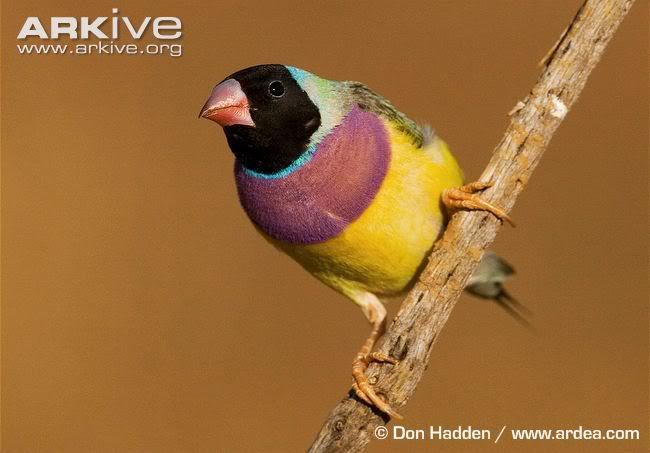
Description
Both sexes are d red markings. The females tend to be less brightly colored. One major difference between the sexes is that the male's chest is purple, while the female's is a lighter mauve.
Gouldian Finches are about 130–140 mm long. Gouldian Finches' heads may be red, black, or yellow. Formerly considered three different kinds of finches, it is now known that these are colour variants that exist in the wild. Selective breeding has also developed mutations (blue, yellow and silver instead of a green back) in both body and breast color.
Juveniles also have distinctive colors. Their heads, sides and necks are grey, and their backs, wings and tail feathers are olive green. Their undersides are pale brown. Beaks are blackish with a reddish tip. Their legs and feet are light brown. Newly-hatched Gouldian Finches are pink and naked until about 12 days old when the beginnings of feathers start to appear. Very young birds also have blue, phosphorescent beads on the sides of their beaks to help their parents see them in the dark.
Distribution and habitat
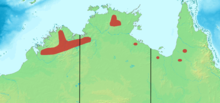
This bird is found in northern Australia, from the Cape York Peninsula through north-west Queensland and the northern Northern Territory to the Kimberley region of Western Australia. Their habitat is tropical savanna woodlands. The birds are nomadic within a relatively small area (approximately 40 square kilometers) and only move when water or food becomes scarce. The largest known wild population of the species is found in the Bastion Hills, next to the town of Wyndham in the eastern Kimberley, where a 28 km2 site – the Wyndham Important Bird Area – has been identified by BirdLife International.
Prior to the Australian government's ban on the export of Australian fauna in 1959, Gouldian Finches were exported worldwide. These birds have resulted in viable breeding populations being held in many countries.
Captive breeding has resulted in a number of colour mutations being established. These include blue-back, pastel, silver, yellow-back, white-breasted, and even pure white specimens.
Conservation status
The number of Gouldian Finches has decreased quite dramatically during the 20th century. Their habitat has been reduced or altered. Early research indicated a parasite called the air sac mite was responsible for the decline of the species. This is no longer considered to be a major factor. In general, Gouldian Finches are susceptible to diseases and viral infections. Their beautiful colours mean that they are easily caught by predators. Fires are listed as the primary threat to the natural populations. The total number of Gouldian Finches altogether is not low, however, because they are among the most popular pet birds, and are bred in captivity for the pet trade.
Recovery plans are in place to recover and conserve its natural habitats, such as building protective fencing to prevent damage by cattle. Attempts at reintroduction have so far proved unsuccessful. It was also suggested to develop management guidelines for land-holders about appropriate land management, promoting the recovery program, and Gouldian Finch conservation.
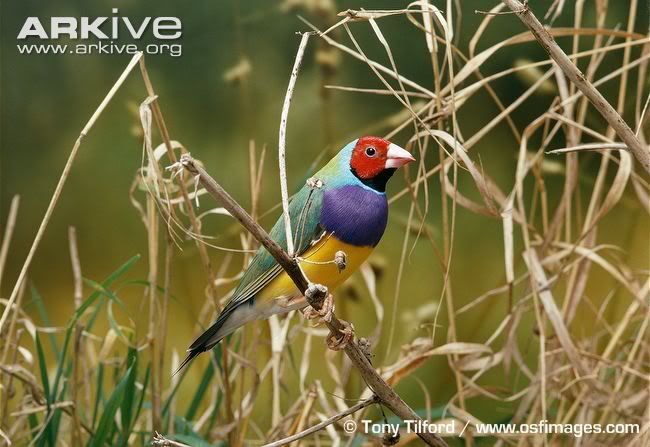
Important Bird Areas
BirdLife International has identified the following sites as being important for Gouldian Finches:
Northern Territory: Keep River & Yinberrie Hills
Western Australia: Mornington Sanctuary & Wyndham
Behaviour
Although often bred in a colony in captivity, in the wild, the Gouldian is not a colony bird. Outside the breeding season, however, Gouldian Finches often join mixed flocks consisting of Long-tailed Finches and Masked Finches. This is probably a defense against predation. Flocks used to consist of up to 1,000–2,000 individuals. During the breeding season they are usually found on rough scree slopes where vegetation is sparse. In the dry season, they are more nomadic and will move to wherever there is food and water.
Feeding
Like other finches, the Gouldian Finch is a seed eater. During the breeding season, Gouldian Finches feed mostly on ripe or half-ripe grass seeds of sorghum. During the dry season, they forage on the ground for fallen seed. During the wet season, spinifex grass seed (Triodia sp.) is an important component of their diet. So far Gouldians have been recorded as consuming six different species of grass seed, but during crop analysis, researchers have yet to find evidence of insect consumption.
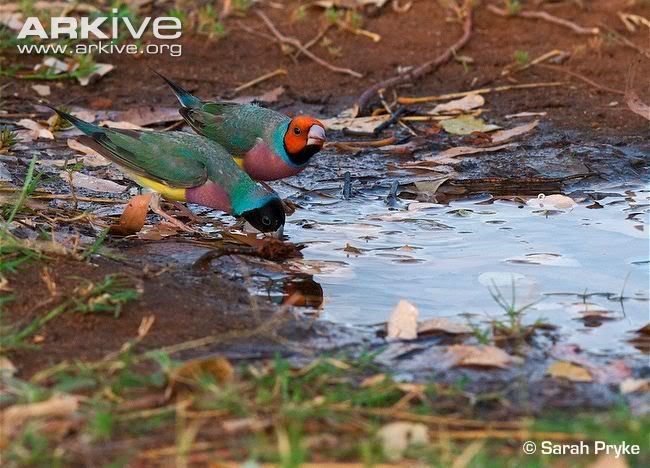
Breeding
Gouldian finches generally make their nests in tree-holes, generally within a kilometer or so of water. They usually breed in the early part of the dry season, when there is plenty of food around. The male courtship dance is a fascinating spectacle. When a male is courting a female, he bobs about ruffling his feathers to show off his colors. He expands his chest and fluffs out his forehead feathers. After mating, a female lays a clutch of about 4–8 eggs. Both parents help brood the eggs during the daytime, and the female stays on the eggs at night. When the eggs hatch, both parents help care for the young. Gouldian Finches leave the nest at between 19 and 23 days and are independent at 40 days old.
Gouldian finches have brightly coloured gapes and call loudly when the parent birds return so that they are able to find and feed their mouths in the dark nest.
Young Gouldians are very fragile until their final moult. Some breeders believe parent-raised Gouldians have greater success rearing young than those fostered by other species, such as Society finches or Spice Finches.
It has been shown scientifically that female finches from Northern Australia are controlling the sex of their offspring, according to the head color of their male counterpart. Gouldian Finches should not be mated with Gouldian Finches of a different head color (black-head with red-head etc.) as such a mating will result in an imbalance in the sex ratio of the young, with a greater proportion of male offspring being produced.
eDNA reveals where endangered birds of a feather flock together
by NESP Northern Australia Environmental Resources Hub
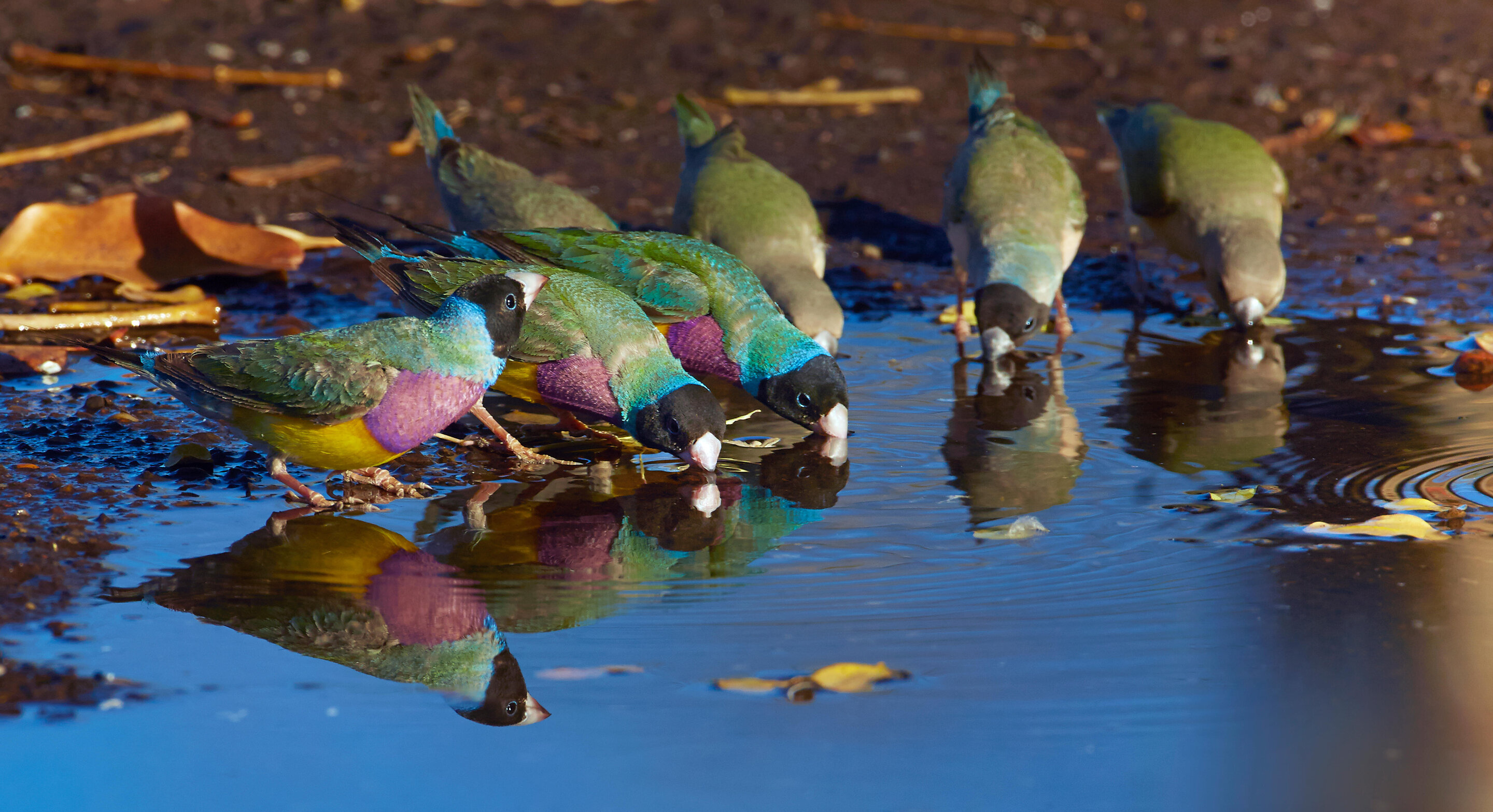
Gouldian finches drinking, Wyndham, Kimberley, Western Australia Credit: Minden Pictures & Alamy Photo
For the first time, Australian scientists have shown that environmental DNA (eDNA) can be used to detect the presence of an endangered bird species simply by collecting a cupful of water from the pools where they drink.
eDNA has emerged as powerful tool to trace rare and threatened aquatic species but its application in the detection of threatened terrestrial species is still largely untested. Researchers from Charles Darwin University, The University of Western Australia, and the Northern Territory's Department of Environment and Natural Resources (DENR) have developed a genetic probe that targets and identifies the eDNA of the endangered Gouldian finch (Erythrura gouldiae), a rainbow-coloured grassfinch endemic to the savanna woodlands of northern Australia.
"When it worked in the real world at the waterholes, even where the water was poor quality in places—where it was hot and looked a bit oily—we were really excited" says Professor Karen Gibb of Charles Darwin University, who led the study funded by the Australian Government's National Environmental Science Program.
The eDNA test has the potential to increase our knowledge of the distribution and habitat use of Gouldian finches; essential information to guide land management decisions that will assist the recovery of wild populations.
Gouldian finches were once found in their thousands from the Kimberley region of Western Australia across to Cape York Peninsula in Queensland. The expansion of pastoralism in the first half of the 20th century and changes in the timing and intensity of fires has been linked to the historical decline in the numbers of Gouldian finches, most likely owing to the reduced availability of the grass seeds that form the major part of their diet. Because the finches are found in small groups across the vast, remote and sparsely populated north of Australia, researchers can't always predict where they need to be and when they need to be there to encounter the birds. This makes it difficult to track changes in the numbers of Gouldian finches from year to year.
Yet there is one aspect of their behaviour that researchers can predict: the granivorous Gouldian finches need to drink water each day. As the northern dry season progresses, suitable waterholes become smaller and rarer. The burst of concentrated activity as flocks of finches drink from shrinking waterholes meant they were likely to shed traceable amounts of their DNA into the water.
The researchers developed a two-in-one eDNA test that uses a PCR primer to amplify a fragment of mitochondrial DNA found in estrildid finches and a species-specific probe to detect Gouldian finch DNA. Gouldian finches often drink at waterholes in mixed flocks with masked finches (Poephila personata) and long-tailed finches (P. acuticauda), which are also members of the estrildid family of finches.
"It's a much more accurate test," Professor Gibb says. "By having primers that pick-up other finches it tells us that the eDNA is good enough quality to be amplified. If the Gouldian test is then negative we can be confident that the eDNA test worked, but there just weren't Gouldian finches at that site."
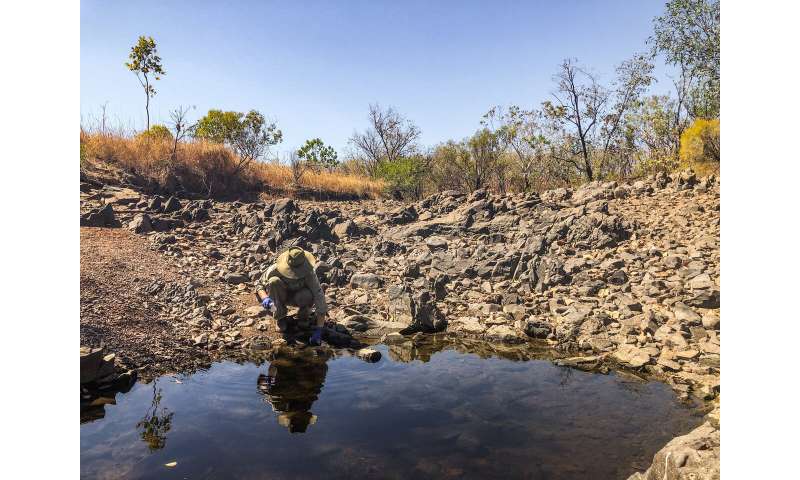
Sampling for gouldian finch environmental DNA in the Yinberrie Hills, Northern Territory, Australia. Credit: Northern Territory Department of Environment and Natural Resources.
They trialled the eDNA test in aviaries at the Territory Wildlife Park before field trials at the Yinberrie Hills near Katherine. Scientists from the NT Department of Environment and Natural Resources and Indigenous Jawoyn Rangers have been monitoring Gouldian finches at the Yinberrie Hills since 1996, so there was concurrent count data to validate the eDNA results.
The study, published in Endangered Species Research, showed that Gouldian finch eDNA could be reliably detected from a 200 mL water sample collected from waterholes visited by the birds in the previous 48 hours. At waterholes with the highest number of birds, Gouldian finch DNA was still detectable 14 days after sample collection, regardless of whether the sample was stored at room temperature or refrigerated. A more comprehensive field trial, where protocols for sampling, storage and the eDNA test will be refined, is currently underway.
Having a reliable and accurate eDNA test for Gouldian finches means that Indigenous Rangers and other land managers, as well as scientists, could collect water samples as they move across the landscape undertaking other activities.
"People who are travelling around will be able to put a cup of water into an appropriate container and then into a car fridge, and be able to take a lot of samples," Professor Gibb says. "We can cover a much larger area."
phys.org/news/2019-11-edna-reveals-endangered-birds-feather.html
Journal Reference:
K Day et al, Development and validation of an environmental DNA test for the endangered Gouldian finch, Endangered Species Research (2019). DOI: 10.3354/esr00987
www.int-res.com/abstracts/esr/v40/p171-182/

Scientific classification
Kingdom: Animalia
Phylum: Chordata
Class: Aves
Order: Passeriformes
Family: Estrildidae
Genus: Erythrura
Species: Erythrura gouldiae
The Gouldian Finch, Erythrura gouldiae (or Chloebia gouldiae), also known as the Lady Gouldian Finch, Gould's Finch or the Rainbow Finch, is a colorful passerine bird endemic to Australia. There is strong evidence of a continuing decline, even at the best-known site near Katherine in the Northern Territory. Large numbers are bred in captivity, particularly in Australia. In the state of South Australia, National Parks & Wildlife Department permit returns in the late 1990s showed that over 13,000 Gouldian Finches were being kept by aviculturists. If extrapolated to an Australia-wide figure this would result in a total of over 100,000 birds. In 1992, it was classified as "Endangered in the wild" under IUCN's criteria C2ai. This was because the viable population size was estimated to be less than 2,500 mature individuals, no permanent subpopulation was known to contain more than 250 mature individuals, and that a continuing decline was observed in the number of mature individuals. It is currently subject to a conservation program.
Taxonomy
The Gouldian Finch was described by British ornithological artist John Gould in 1844 and named after his wife Elizabeth. It is also known in America as the Rainbow Finch, Gould's Finch, or the Lady Gouldian Finch (although Mrs. Gould did not hold the title Lady). In Australia, it is predominantly called the Gouldian Finch. It is a member of the weaver-finch family Estrildidae, which is sometimes considered a subfamily of Passeridae.
Origin
Origin and phylogeny has been obtained by Antonio Arnaiz-Villena et al. Estrildinae may have originated in India and dispersed thereafter (towards Africa and Pacific Ocean habitats).

Description
Both sexes are d red markings. The females tend to be less brightly colored. One major difference between the sexes is that the male's chest is purple, while the female's is a lighter mauve.
Gouldian Finches are about 130–140 mm long. Gouldian Finches' heads may be red, black, or yellow. Formerly considered three different kinds of finches, it is now known that these are colour variants that exist in the wild. Selective breeding has also developed mutations (blue, yellow and silver instead of a green back) in both body and breast color.
Juveniles also have distinctive colors. Their heads, sides and necks are grey, and their backs, wings and tail feathers are olive green. Their undersides are pale brown. Beaks are blackish with a reddish tip. Their legs and feet are light brown. Newly-hatched Gouldian Finches are pink and naked until about 12 days old when the beginnings of feathers start to appear. Very young birds also have blue, phosphorescent beads on the sides of their beaks to help their parents see them in the dark.
Distribution and habitat

This bird is found in northern Australia, from the Cape York Peninsula through north-west Queensland and the northern Northern Territory to the Kimberley region of Western Australia. Their habitat is tropical savanna woodlands. The birds are nomadic within a relatively small area (approximately 40 square kilometers) and only move when water or food becomes scarce. The largest known wild population of the species is found in the Bastion Hills, next to the town of Wyndham in the eastern Kimberley, where a 28 km2 site – the Wyndham Important Bird Area – has been identified by BirdLife International.
Prior to the Australian government's ban on the export of Australian fauna in 1959, Gouldian Finches were exported worldwide. These birds have resulted in viable breeding populations being held in many countries.
Captive breeding has resulted in a number of colour mutations being established. These include blue-back, pastel, silver, yellow-back, white-breasted, and even pure white specimens.
Conservation status
The number of Gouldian Finches has decreased quite dramatically during the 20th century. Their habitat has been reduced or altered. Early research indicated a parasite called the air sac mite was responsible for the decline of the species. This is no longer considered to be a major factor. In general, Gouldian Finches are susceptible to diseases and viral infections. Their beautiful colours mean that they are easily caught by predators. Fires are listed as the primary threat to the natural populations. The total number of Gouldian Finches altogether is not low, however, because they are among the most popular pet birds, and are bred in captivity for the pet trade.
Recovery plans are in place to recover and conserve its natural habitats, such as building protective fencing to prevent damage by cattle. Attempts at reintroduction have so far proved unsuccessful. It was also suggested to develop management guidelines for land-holders about appropriate land management, promoting the recovery program, and Gouldian Finch conservation.

Important Bird Areas
BirdLife International has identified the following sites as being important for Gouldian Finches:
Northern Territory: Keep River & Yinberrie Hills
Western Australia: Mornington Sanctuary & Wyndham
Behaviour
Although often bred in a colony in captivity, in the wild, the Gouldian is not a colony bird. Outside the breeding season, however, Gouldian Finches often join mixed flocks consisting of Long-tailed Finches and Masked Finches. This is probably a defense against predation. Flocks used to consist of up to 1,000–2,000 individuals. During the breeding season they are usually found on rough scree slopes where vegetation is sparse. In the dry season, they are more nomadic and will move to wherever there is food and water.
Feeding
Like other finches, the Gouldian Finch is a seed eater. During the breeding season, Gouldian Finches feed mostly on ripe or half-ripe grass seeds of sorghum. During the dry season, they forage on the ground for fallen seed. During the wet season, spinifex grass seed (Triodia sp.) is an important component of their diet. So far Gouldians have been recorded as consuming six different species of grass seed, but during crop analysis, researchers have yet to find evidence of insect consumption.

Breeding
Gouldian finches generally make their nests in tree-holes, generally within a kilometer or so of water. They usually breed in the early part of the dry season, when there is plenty of food around. The male courtship dance is a fascinating spectacle. When a male is courting a female, he bobs about ruffling his feathers to show off his colors. He expands his chest and fluffs out his forehead feathers. After mating, a female lays a clutch of about 4–8 eggs. Both parents help brood the eggs during the daytime, and the female stays on the eggs at night. When the eggs hatch, both parents help care for the young. Gouldian Finches leave the nest at between 19 and 23 days and are independent at 40 days old.
Gouldian finches have brightly coloured gapes and call loudly when the parent birds return so that they are able to find and feed their mouths in the dark nest.
Young Gouldians are very fragile until their final moult. Some breeders believe parent-raised Gouldians have greater success rearing young than those fostered by other species, such as Society finches or Spice Finches.
It has been shown scientifically that female finches from Northern Australia are controlling the sex of their offspring, according to the head color of their male counterpart. Gouldian Finches should not be mated with Gouldian Finches of a different head color (black-head with red-head etc.) as such a mating will result in an imbalance in the sex ratio of the young, with a greater proportion of male offspring being produced.
eDNA reveals where endangered birds of a feather flock together
by NESP Northern Australia Environmental Resources Hub

Gouldian finches drinking, Wyndham, Kimberley, Western Australia Credit: Minden Pictures & Alamy Photo
For the first time, Australian scientists have shown that environmental DNA (eDNA) can be used to detect the presence of an endangered bird species simply by collecting a cupful of water from the pools where they drink.
eDNA has emerged as powerful tool to trace rare and threatened aquatic species but its application in the detection of threatened terrestrial species is still largely untested. Researchers from Charles Darwin University, The University of Western Australia, and the Northern Territory's Department of Environment and Natural Resources (DENR) have developed a genetic probe that targets and identifies the eDNA of the endangered Gouldian finch (Erythrura gouldiae), a rainbow-coloured grassfinch endemic to the savanna woodlands of northern Australia.
"When it worked in the real world at the waterholes, even where the water was poor quality in places—where it was hot and looked a bit oily—we were really excited" says Professor Karen Gibb of Charles Darwin University, who led the study funded by the Australian Government's National Environmental Science Program.
The eDNA test has the potential to increase our knowledge of the distribution and habitat use of Gouldian finches; essential information to guide land management decisions that will assist the recovery of wild populations.
Gouldian finches were once found in their thousands from the Kimberley region of Western Australia across to Cape York Peninsula in Queensland. The expansion of pastoralism in the first half of the 20th century and changes in the timing and intensity of fires has been linked to the historical decline in the numbers of Gouldian finches, most likely owing to the reduced availability of the grass seeds that form the major part of their diet. Because the finches are found in small groups across the vast, remote and sparsely populated north of Australia, researchers can't always predict where they need to be and when they need to be there to encounter the birds. This makes it difficult to track changes in the numbers of Gouldian finches from year to year.
Yet there is one aspect of their behaviour that researchers can predict: the granivorous Gouldian finches need to drink water each day. As the northern dry season progresses, suitable waterholes become smaller and rarer. The burst of concentrated activity as flocks of finches drink from shrinking waterholes meant they were likely to shed traceable amounts of their DNA into the water.
The researchers developed a two-in-one eDNA test that uses a PCR primer to amplify a fragment of mitochondrial DNA found in estrildid finches and a species-specific probe to detect Gouldian finch DNA. Gouldian finches often drink at waterholes in mixed flocks with masked finches (Poephila personata) and long-tailed finches (P. acuticauda), which are also members of the estrildid family of finches.
"It's a much more accurate test," Professor Gibb says. "By having primers that pick-up other finches it tells us that the eDNA is good enough quality to be amplified. If the Gouldian test is then negative we can be confident that the eDNA test worked, but there just weren't Gouldian finches at that site."

Sampling for gouldian finch environmental DNA in the Yinberrie Hills, Northern Territory, Australia. Credit: Northern Territory Department of Environment and Natural Resources.
They trialled the eDNA test in aviaries at the Territory Wildlife Park before field trials at the Yinberrie Hills near Katherine. Scientists from the NT Department of Environment and Natural Resources and Indigenous Jawoyn Rangers have been monitoring Gouldian finches at the Yinberrie Hills since 1996, so there was concurrent count data to validate the eDNA results.
The study, published in Endangered Species Research, showed that Gouldian finch eDNA could be reliably detected from a 200 mL water sample collected from waterholes visited by the birds in the previous 48 hours. At waterholes with the highest number of birds, Gouldian finch DNA was still detectable 14 days after sample collection, regardless of whether the sample was stored at room temperature or refrigerated. A more comprehensive field trial, where protocols for sampling, storage and the eDNA test will be refined, is currently underway.
Having a reliable and accurate eDNA test for Gouldian finches means that Indigenous Rangers and other land managers, as well as scientists, could collect water samples as they move across the landscape undertaking other activities.
"People who are travelling around will be able to put a cup of water into an appropriate container and then into a car fridge, and be able to take a lot of samples," Professor Gibb says. "We can cover a much larger area."
phys.org/news/2019-11-edna-reveals-endangered-birds-feather.html
Journal Reference:
K Day et al, Development and validation of an environmental DNA test for the endangered Gouldian finch, Endangered Species Research (2019). DOI: 10.3354/esr00987
www.int-res.com/abstracts/esr/v40/p171-182/


